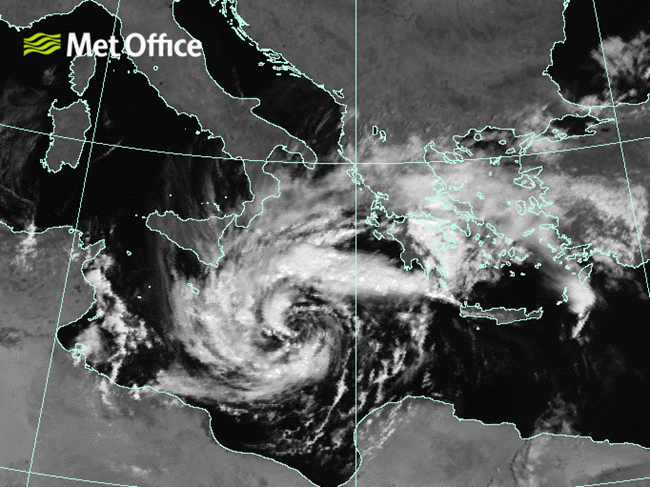Europe is usually safe from hurricanes, far from the tropical waters that whip them up before firing them one after another into the U.S. East Coast at this time of year.
But a rare hurricane-like system, called a medicane, formed over the Mediterranean last week, killing 5 people with flash floods in Tunisia, before tearing into the Greek islands.
Local media reported that the Greek island of Peloponnese was hit by hurricane force winds (over 73 mph) on Saturday, Sept. 29, as the storm swept over before weakening and heading on to Bulgaria.
Turkey was braced for the slow-moving storm to hit on Monday morning.
#Medicane #Zorbas making landfall in Mani, Peloponnese! Report: George Kallidonis pic.twitter.com/3faJzCifs9
— severe-weather.EU (@severeweatherEU) September 29, 2018
Europe’s experience of hurricanes is usually limited to the odd storm that turns hard right into the Atlantic, loses shape, spin, and scatters its feeble remnants on the British Isles.
The Mediterranean is too cold and small to regularly cook up the spinning cyclonic systems spawned by the hot waters of the tropics in the Pacific and Atlantic oceans.
But occasionally, the Mediterranean produces a hurricane-like system, called a medicane (“Mediterranean” combined with “hurricane”).
Zorba the Greek
Sea temperatures are unusually high for the time of year, reaching as high as 28 C (82 F), pumping more moisture into the system and fueling thunderstorms and potential tornados.
The storm has been nicknamed “Zorba,” but medicanes are not assigned official names.
Projected course of the #medicane 'Zorba'. pic.twitter.com/u0vVi3dB9x
— Nike Margaret Morgan (@NikeMorgan) September 29, 2018
European weather services predicted that the storm could dump over a foot of water in a day and a half.
Julian Heming, a tropical cyclone expert at the British Met Office weather service, said the storm was formed by a clash of cold air pushing south over the Balkans and warm air moving north from Africa.
Hemings said, “However, as it has strengthened over the warm waters of the Mediterranean Sea it is starting to acquire some characteristics of a tropical cyclone.”
“Bands of thunderstorms are starting to wrap around the low pressure centre, although are not yet concentrated close to the centre as you might see in a fully ‘tropical’ cyclone,” she said in a statement.
The Met office describes Medicanes as unusual, but not rare. However, a paper in meteorological journal in 2011 noted that “Medicanes are considered rare phenomena, since only a few have been directly observed.”
Medicanes can reach a similar strength to a Category 1 hurricane.
Three-quarters of Greece was put on alert with warnings of flooding and schools in the Greek capital and several other parts of the country closed for the day before the storm hit.
Boats were flipped upside down and dumped on the beach at the seaside town of Methoni, famous for its Venetian castle, according to local media.
A few hundred miles away from the eye of the storm, in the Sicilian town of Stazzo, massive waves swamped sea defenses as people struggled to secure their boats in the harbor.
After scraping past Turkey and Bulgaria, the weakened storm system is expected to head into the Black Sea and then on into Russia’s Volga region and possibly Ukraine.
The storm is the second natural disaster to hit Greece in recent months. In July, at least 80 people were killed in the worst forest fire in a decade.
From The Epoch Times


